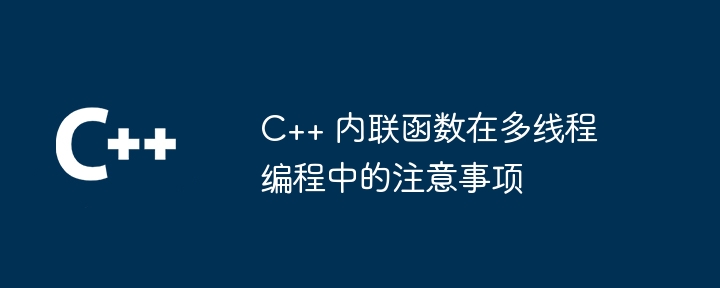Home >Backend Development >C++ >Things to note about C++ inline functions in multi-threaded programming
Things to note about C++ inline functions in multi-threaded programming
- WBOYWBOYWBOYWBOYWBOYWBOYWBOYWBOYWBOYWBOYWBOYWBOYWBOriginal
- 2024-04-16 18:21:01606browse
多线程编程中使用内联函数需注意:1.避免数据竞态条件:内联函数可能修改共享数据,使用互斥锁或原子操作进行保护。2.确保可重入性:内联函数应是可重入的,避免使用局部静态变量或依赖线程局部存储。

C++ 内联函数在多线程编程中的注意事项
内联函数是一种通过编译器将函数体直接插入调用点的编译优化技术。虽然它可以提高性能,但在多线程编程中使用内联函数时需要注意以下事项:
数据竞态条件
内联函数可以修改被多个线程共享的数据,从而导致数据竞态条件。例如:
inline void incrementCounter(int& counter) {
counter++;
}如果多个线程同时调用 incrementCounter() 函数,就可能导致对 counter 变量进行不正确的加法,从而产生不可预期的结果。为了避免这种情况,需要使用互斥锁或原子操作来保护共享数据。
可重入性
内联函数必须是可重入的,这意味着它们可以同时被多个线程调用而不会导致错误。如果内联函数使用局部静态变量或依赖于线程局部存储 (TLS),则可能不是可重入的。
// 不是可重入的内联函数
inline int getThreadId() {
static int tid = 0;
return ++tid;
}实战案例
考虑一个使用内联函数计算字符串长度的多线程程序:
inline size_t strlen(const char *str) {
size_t len = 0;
while (*str != '\0') {
len++;
str++;
}
return len;
}
// 多线程函数
void processStrings(const char **strings, size_t numStrings) {
#pragma omp parallel for
for (size_t i = 0; i < numStrings; i++) {
size_t len = strlen(strings[i]);
... // 使用 len
}
}由于 strlen() 函数内联,因此编译器会将函数体直接插入 processStrings() 的各个循环迭代中。这可能导致数据竞态条件,因为多个线程可能会同时访问指针 str 并导致段错误。
为了解决这个问题,可以将 strlen() 函数声明为非内联:
size_t strlen(const char *str);
这将强制编译器将函数体作为独立的代码块编译,并确保它在多个线程中正确运行。
The above is the detailed content of Things to note about C++ inline functions in multi-threaded programming. For more information, please follow other related articles on the PHP Chinese website!

